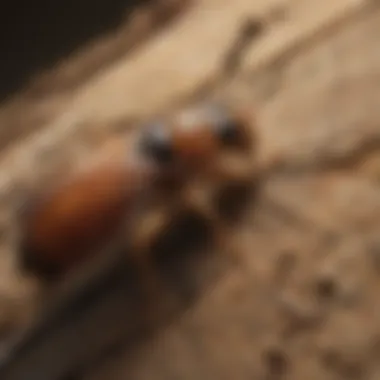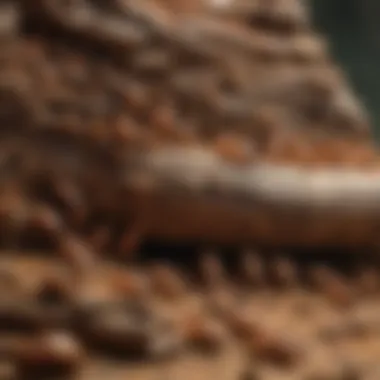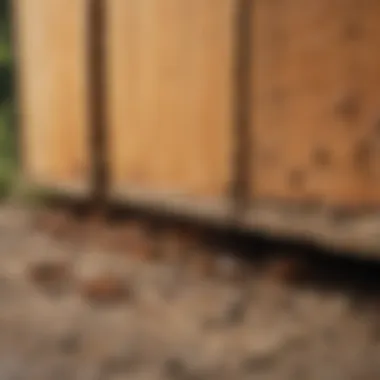Comprehensive Guide to Understanding Drywood Termites in Southern California


Preventive Pest Control Strategies
When it comes to safeguarding your home from the destructive tendencies of drywood termites in Southern California, implementing preventive pest control strategies is paramount. Starting with your house exterior, sealing cracks and crevices serves as a first line of defense against termite intrusion. Clearing debris like fallen branches and leaves eliminates hiding spots for these pests, preventing them from entering your home. Ensuring a well-maintained yard is also essential. Regular yard care routines such as mowing the lawn and trimming shrubs not only enhance the aesthetics of your property but also keep it pest-free.
Maintaining indoor cleanliness is crucial in deterring termites. Expert cleaning tips and techniques can help create a pest-resistant indoor environment. Regularly vacuuming, dusting, and decluttering reduce the places where termites can hide and thrive. Proper garbage disposal is another key aspect of pest prevention. Using efficient waste disposal methods and securing trash cans can help eliminate attractants for termites and other pests. Additionally, exploring innovative ways to safeguard your home, such as installing termite barriers or using eco-friendly pest repellents, can further fortify your defenses against termite infestations.
Identifying Pest Risk Areas
Conducting thorough inspections to identify pest risk areas in and around your home is critical for effective pest management. Begin with inspecting moisture-prone areas, such as basements and crawl spaces, for signs of damp conditions that can attract termites. Implementing proper ventilation and installing dehumidifiers can help prevent infestations in these areas. Inspection of cracks and crevices in your home is also essential. Sealing these access points with appropriate materials can stop termites from infiltrating your living spaces. Additionally, carefully evaluating the impact of greenery around your property on pest presence is important. Overgrown vegetation can create pathways for termites to access your home, so maintaining a well-trimmed yard is essential. Lastly, being aware of other pest risk areas, such as utility lines or outdoor storage sheds, and taking preventive measures for these spots can further enhance your pest control efforts.
Effective Pest Control Methods
In the event of a termite infestation, deploying effective pest control methods is crucial to eradicate these pests efficiently. Natural repellents using essential oils, herbs, and plants can offer a safe and eco-friendly solution to deter termites from your property. Chemical sprays, when used according to professional guidelines, can effectively eliminate termite colonies. Utilizing pest traps is another method for controlling termite populations. Setting up traps in strategic locations can help capture and remove termites non-invasively. Biological control methods, such as introducing natural predators of termites, offer an environmentally-friendly approach to pest management. Exploring other innovative pest control methods beyond traditional options can provide alternative solutions for combating termites and other pests.
Pest Species Identification
Being able to identify common insects, rodents, birds, and wildlife that pose a threat to your property is essential for effective pest prevention. Recognizing signs of insect infestations, like ant trails or spider webs, allows for prompt intervention to control these pests. Understanding the behavior and habitats of rodents, such as mice and rats, can aid in implementing targeted prevention strategies to keep them at bay. Addressing bird-related issues, such as nesting near eaves or creating mess around the yard, is crucial for maintaining a pest-free home environment. Additionally, knowing how to handle wildlife encounters, whether it's raccoons or squirrels, can help prevent property damage and ensure your safety. Identifying and managing lesser-known pests effectively rounds out your knowledge, equipping you with a comprehensive understanding of potential threats to your property.
DIY Pest Control Techniques
For those inclined towards a hands-on approach to pest control, DIY techniques offer practical and cost-effective solutions. Homemade pest control remedies using common household ingredients can provide eco-friendly alternatives to commercial pesticides. Essential oils, known for their repellent properties, can be utilized to create a bug-free environment at home without harsh chemicals. Setting up effective pest traps and barriers, such as sticky traps or physical barriers, can aid in controlling and preventing pest infestations. Utilizing products from reputable pest control brands that offer a range of solutions for home pest management ensures the quality and efficacy of your control measures. Exploring miscellaneous DIY pest control techniques, like using diatomaceous earth or planting pest-repelling herbs in your garden, presents innovative approaches to managing various pest issues effectively.
Introduction
Drywood termites in Southern California are a significant concern for homeowners due to their destructive nature and widespread presence. This introductory section sets the stage for a comprehensive exploration of these pests, shedding light on their behavior, the damage they cause, and effective prevention and treatment strategies. By delving into the intricacies of drywood termites, readers will gain valuable insights to protect their properties from potential infestations.
Overview of Drywood Termites
Drywood termites are adept at creating extensive damage to wooden structures, making them a formidable threat to homes in Southern California. Understanding their physical description, habitat, distribution, and importance in this region is crucial for implementing targeted control measures.
Physical Description


The physical characteristics of drywood termites set them apart from other termite species. With their compact bodies, pale coloration, and lack of a need for moisture, these termites can easily infest dry wood structures without detection. Their ability to burrow deep into wooden materials makes them challenging to spot and eradicate, leading to significant structural damage over time.
Habitat and Distribution
Drywood termites thrive in warm, arid climates such as Southern California, where the dry conditions provide an ideal environment for their survival. Their distribution spans across residential areas, with a preference for wooden constructions that offer ample nesting and feeding opportunities. This extensive distribution heightens the risk of infestations and underscores the importance of proactive pest management strategies.
Importance in Southern California
In Southern California, drywood termites pose a continuous threat to homes and buildings due to the region's climate and prevalent use of wood in construction. The economic impact of termite damage in this area is significant, necessitating ongoing vigilance and preventative measures to safeguard properties. Recognizing the importance of combating drywood termite infestations is essential for homeowners to preserve the integrity of their structures and avoid costly repairs.
Life Cycle and Behavior
An exploration of the life cycle and behavior of drywood termites offers invaluable insights into their reproductive patterns, nesting habits, and foraging behavior. By understanding these aspects, homeowners can better anticipate and address potential infestations promptly.
Primary Castes
Drywood termite colonies consist of distinct castes, including workers, soldiers, and reproductives, each with specialized roles within the colony. Workers are responsible for tunneling, foraging, and feeding, while soldiers defend the colony against threats. Reproductive termites are winged and play a crucial role in establishing new colonies, perpetuating the termite population.
Nesting Habits
Drywood termites construct their nests within the wood they infest, creating elaborate systems of tunnels and chambers to house the colony. These nests provide protection from predators and environmental conditions, allowing the termites to thrive and reproduce within the safety of their wooden environment.
Foraging Patterns
The foraging behavior of drywood termites involves the systematic search for new food sources and nesting sites. These termites can travel considerable distances from their central colony to locate suitable wood for consumption, leaving behind telltale signs of their presence through feeding galleries and frass. Understanding their foraging patterns is crucial for implementing targeted treatment and prevention strategies to mitigate infestations effectively.
Identification
Distinctive Features
Physical Characteristics
Exploring the physical characteristics of drywood termites sheds light on key attributes that set them apart from other termite species. The unique features of drywood termites' physical composition, including their pale cream-colored bodies and lack of a worker caste, contribute significantly to their identification. These distinct physical traits make them easily distinguishable from subterranean termites, aiding in accurate identification during inspections and infestation assessments. While their lack of a worker caste may seem disadvantageous, it actually enhances their ability to directly consume wood, causing extensive damage to structures in a shorter period.


Signs of Infestation
Understanding the signs of a drywood termite infestation is paramount in detecting and addressing potential threats to properties. The presence of distinctive indicators such as frass (termite droppings), discarded wings, and hollow-sounding wood can signal a burgeoning infestation. These signs not only point towards infestation but also offer insights into the extent of damage already incurred. Recognizing these infestation markers empowers homeowners to intervene promptly, mitigating further destruction and financial repercussions. Being able to identify these signs early on is key to implementing timely treatment measures and minimizing structural harm.
Comparison with Other Termite Species
Differences
Distinguishing drywood termites from other termite species involves analyzing specific differences in behavior, habitat preferences, and nesting habits. Understanding these distinctions is vital in accurately identifying the type of termite infesting a property and tailoring treatment methods accordingly. One notable difference lies in drywood termites' ability to establish colonies within the wood they infest, foregoing the need for direct contact with soil. This behavior sets them apart from subterranean termites, which rely on maintaining contact with soil for moisture and survival. By recognizing these behavioral differences, homeowners can address infestations effectively and prevent recurrence.
Similarities
While there are distinct differences between drywood termites and other termite species, certain similarities exist in terms of their destructive capabilities and impact on wooden structures. Like subterranean termites, drywood termites feed on cellulose found in wood, causing structural damage over time. Both species require intervention through fumigation or other treatment methods to eradicate infestations completely. Understanding these shared traits provides a broader perspective on termite behavior and reinforces the importance of proactive identification and prevention measures.
Damage Caused
In this section of the article, we will delve into the critical topic of the damage caused by drywood termites, shedding light on its significance in understanding the impact of these pests on properties in Southern California. The damage caused by these termites can be extensive and have severe implications for homeowners. By comprehensively exploring this aspect, we can grasp the full extent of the threat posed by drywood termites and the urgency of effective preventive measures and treatment strategies.
Structural Impact
Wooden Structures Affected
Wooden structures are particularly vulnerable to drywood termite damage due to these insects' ability to burrow deep into the wood, compromising its structural integrity. The intricate tunnels created by termites can weaken wood significantly, leading to potential safety hazards within a property. Understanding the specific vulnerabilities of wooden structures affected by drywood termites is crucial for implementing targeted protection measures. By emphasizing the unique challenges posed by drywood termite infestations in wooden structures, we can highlight the necessity of proactive intervention to safeguard homes from structural compromise.
Extent of Damage
The extent of damage caused by drywood termites can vary, ranging from surface-level deterioration to profound structural weakening. This variability underscores the insidious nature of termite infestations, as initial signs of damage may not accurately represent the full extent of the problem. Recognizing the potential for widespread and hidden damage is key to mitigating the long-term consequences of a termite presence. By exploring the extent of damage in detail, we can underscore the critical need for thorough inspections and comprehensive treatment approaches to address termite infestations effectively.
Financial Consequences
Repair Costs


The financial repercussions of drywood termite infestations can be substantial, with repair costs often escalating rapidly as damage progresses. Repairing structural harm inflicted by termites requires professional intervention and may involve extensive renovations to rectify the compromised areas. Understanding the factors that contribute to repair costs is essential for homeowners to estimate the financial implications of termite damage accurately. By dissecting the components of repair costs, we can provide actionable insights into budgeting and planning for necessary restoration efforts.
Insurance Coverage
Navigating insurance coverage for termite damage can be complex, as standard homeowner's insurance policies typically do not include provisions for termite infestations. However, some insurance options may offer additional coverage or supplemental policies that address specific instances of termite damage. Analyzing the nuances of insurance coverage related to termite damage is crucial for homeowners seeking financial protection against unexpected costs. By elucidating the landscape of insurance options and coverage limitations, we can empower homeowners to make informed decisions regarding risk management and financial preparedness.
Prevention Methods
Home Maintenance Practices
Moisture Control
Moisture Control plays a pivotal role in the prevention of termite infestations. In this article, it is imperative to emphasize the significance of maintaining optimal moisture levels to deter Drywood Termites from invading wooden structures. The key characteristic of Moisture Control lies in its ability to create an environment that is less hospitable to termites, serving as a proactive measure against potential infestations. The unique feature of Moisture Control is its ability to target one of the primary attractions for termites – moisture – effectively reducing the likelihood of termite presence. While Moisture Control offers substantial benefits in preventing termite damage, it is essential to regularly monitor and adjust moisture levels to ensure effectiveness.
Wood Inspection
Wood Inspection plays a vital role in early detection and prevention of termite infestations, making it a standout practice in this article. Highlighting the importance of thorough wood inspections aids in identifying potential termite activity before significant damage occurs. The key characteristic of Wood Inspection is its ability to uncover subtle signs of infestation that may go unnoticed without a detailed inspection. The unique feature of Wood Inspection lies in its ability to provide insight into the extent of termite damage and the urgency of preventive measures required. While Wood Inspection is a beneficial choice for preemptive termite control, it can be labor-intensive and require expertise to conduct thorough assessments accurately.
Treatment Options
Fumigation
Diving into treatment options for Drywood Termites, Fumigation emerges as a prominent method with significant contributions to termite control. Fumigation is a popular choice due to its thorough eradication of termite colonies within infested structures, ensuring comprehensive pest removal. The key characteristic of Fumigation is its ability to penetrate deep into wood surfaces, reaching hidden termite colonies that may not be easily accessible. The unique feature of Fumigation lies in its ability to provide a rapid solution to severe infestations, offering a swift resolution to termite problems. While Fumigation can be highly effective in eliminating termites, it is essential to follow safety protocols and consider potential inconvenience during the fumigation process.
Heat Treatment
Another effective treatment method for Drywood Termites is Heat Treatment, offering a valuable contribution to termite control efforts. Heat Treatment is favored for its ability to target termites through elevated temperatures, effectively eradicating termite populations without the use of chemicals. The key characteristic of Heat Treatment is its eco-friendly approach, appealing to environmentally conscious homeowners seeking non-toxic alternatives for pest control. The unique feature of Heat Treatment lies in its ability to reach all areas of infestation through controlled heat application, ensuring comprehensive termite elimination. While Heat Treatment offers a chemical-free solution to termite infestations, it may require specialized equipment and professional expertise for successful implementation.
Conclusion
Key Takeaways
Understanding the Threat
The key aspect of Understanding the Threat lies in recognizing the relentless nature of drywood termites and their ability to silently cause extensive damage within wooden structures. By understanding the threat posed by these pests, homeowners can proactively implement prevention measures and conduct regular inspections to safeguard their properties. The unique feature of this section is its focus on the stealthy nature of drywood termites, highlighting the challenges of detecting infestations before substantial harm occurs. While challenging, awareness of this threat is paramount for effective termite management.
Effective Strategies
Effective Strategies provide practical solutions for mitigating the risks associated with drywood termite infestations. These strategies encompass a range of preventive measures like moisture control and wood inspections, essential in reducing the attractiveness of properties to termite colonies. Additionally, treatment options such as fumigation and heat treatment offer effective ways to eradicate existing infestations and protect properties from future attacks. The key characteristic of this section is its emphasis on utilizing a combination of prevention and treatment approaches to ensure comprehensive termite management. By detailing the advantages and disadvantages of each strategy, homeowners can make informed decisions on the most suitable methods for their specific situations.



